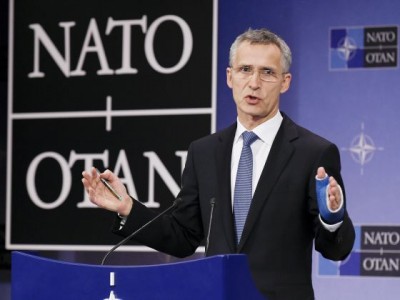NATO Secretary General Says the Western Alliance Is Prepared for “A Situation of War in Europe”

All Global Research articles can be read in 51 languages by activating the “Translate Website” drop down menu on the top banner of our home page (Desktop version).
To receive Global Research’s Daily Newsletter (selected articles), click here.
Visit and follow us on Instagram at @globalresearch_crg.
***
Despite the dialogue, NATO continues to maintain an aggressive rhetoric towards Russia, promising a new armed conflict if current negotiations fail to reach a consensus. In a interview, the Secretary General of NATO stated that the Western military alliance is prepared for a situation of war in Europe if Russia does not collaborate towards a resolution of the Ukrainian issue. More than a warning, Stoltenberg’s attitude appears to be a true boycott against the negotiations and tends to make the pacification of Eastern Europe even more difficult.
Jens Stoltenberg, during a recent interview with the Financial Times, stated that his bloc is prepared for a new armed conflict on European soil in case bilateral negotiations fail. Stoltenberg’s words created an atmosphere of tensions and mistrust on the eve of one of the most important events in recent history between Moscow and NATO – in which terms for the peaceful resolution of the Ukrainian question will be discussed.
These were some of the Secretary’s words:
“I am aware of Russia’s history. For centuries they have experienced conflict with neighbors (…) [But] Russia has an alternative: to co-operate, to work with Nato (…) It is possible to find together a path, a political way forward, and also to address Russia’s concerns… But there continues to be a risk of conflict (…) Nato’s deterrence is credible and strong… We have to hope and work hard for the best, but be prepared for the worst.”
Stoltenberg and the pro-Western analysts justify this type of speech based on the movement of troops operated by the Russians in recent months, mainly in regions close to the border with Ukraine. It is estimated that around 100,000 troops were deployed on the western borders, in addition to military vehicles and other equipment. For months, Washington has been promoting the thesis that this troop movement would be an indication of an alleged Russian invasion plan against Ukraine, which is why tensions increased in 2021, leading to the need to schedule a summit. However, this kind of justification sounds fallacious and weak.
First of all, it must be remembered that at no time did the Russian government try to allocate troops outside its own territorial limits. The moves took place strictly within the Russian State’s sovereign space, which in no way can be interpreted as any kind of international threat. Every state has the right to distribute its military forces throughout its territory in the most convenient and strategic way possible, and it is absolutely normal that a tense zone such as the western border is receiving special attention from Moscow.
Also, the very reason why Russia is acting this way is due to NATO’s previous attitudes in the region. Western maneuvers in Ukraine have been a real threat to the integrity of western Russian territory and the entire Moscow’s strategic environment. And so, it has been the same process for years: NATO allocates troops on the Russian western border and makes threats, which are responded to with mere troop movement (which is an elementary security measure) by Moscow, within Russian territory itself – and then the West promotes the speech that the Russian government is preparing its troops for an invasion of Ukraine.
Considering these facts, Stoltenberg’s words can be interpreted in only one way: the condition for NATO to reach an agreement with Russia on the Ukrainian case is linked to the imposition of limits on Russian troops’ movements within Russian territory. Moscow must give “clear signals” that it does not plan to invade Ukraine – and these signals cannot be the repeated declarations of the Russian government that such a plan does not exist, but something more: a true self-limitation of its own military power. NATO wants Russia to keep its western border insecure, allowing eastern European space to become an arena of western occupation.
This is just another attempt by NATO to subvert the negotiations in order to impose abusive conditions on Russia, trying to make its interests prevail unilaterally, using the threat of war. The problem with this speech is that Stoltenberg’s threat will be interpreted as a bluff. It is very clear to both NATO and Russia that Ukraine is not such an important scenario for the West to the point of justifying the beginning of a war on European soil, with the confrontation of antagonistic nuclear powers.
Stoltenberg just tried, in a very unsophisticated way, to impose the interests of his bloc to intimidate Russia before and during the forthcoming talks. Even if his words are not a bluff and he personally defends the idea of war against Russia, his plans would be frustrated by the governments that are part of the alliance, which would never consider Ukraine a sufficient reason for a new war in Europe.
*
Note to readers: Please click the share buttons above or below. Follow us on Instagram, @crg_globalresearch. Forward this article to your email lists. Crosspost on your blog site, internet forums. etc.
Lucas Leiroz is a researcher in Social Sciences at the Rural Federal University of Rio de Janeiro. Geopolitical consultant.

